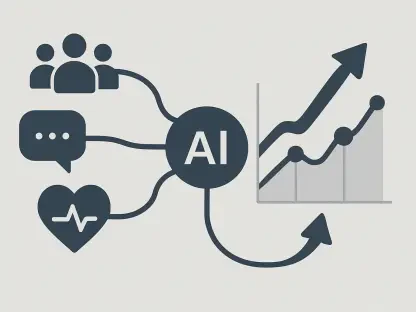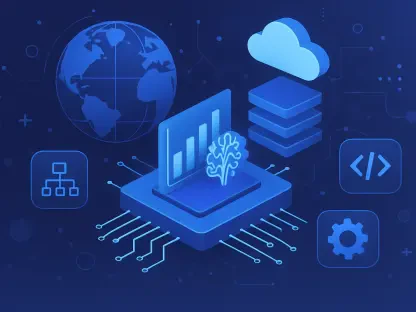The fusion of artificial intelligence and IT operations, known as AIOps, represents a groundbreaking shift in how businesses manage and optimize their IT environments. In a landscape increasingly dominated by complex, cloud-based infrastructures and microservices architectures, AIOps leverages advanced analytics, data correlation, and pattern recognition to deliver unprecedented levels of efficiency and reliability. Originally conceptualized by Gartner, AIOps has evolved to become an indispensable tool for IT operations teams seeking to navigate the intricacies of digital transformation. Through its learning from historical data and continuous feedback, AIOps significantly enhances its ability to detect, analyze, and resolve IT issues, thereby automating repetitive tasks that traditionally consumed vast amounts of time and resources. This automation not only improves operational efficiency but also allows human resources to concentrate on more strategic and innovative aspects of digital initiatives.
Transformative Potential in Complex Infrastructures
The real power of AIOps becomes evident in its transformative potential across various business environments, particularly those with intricate infrastructures. For organizations grappling with complex, cloud-based ecosystems and microservices, AIOps offers a unified view of IT environments, improving performance, reliability, and agility—core components of any successful digital transformation. With predictive analytics at its disposal, AIOps can forecast potential problems and trends, thereby enabling organizations to plan proactively for future challenges. This forward-looking capability is invaluable in today’s fast-paced digital world, where anticipating and mitigating issues can make the difference between seamless operations and costly downtimes.
Additionally, AIOps adapts seamlessly to the dynamic nature of digital transformation. Its scalability and flexibility allow it to manage the growing complexity of IT environments with ease. Whether it’s handling an influx of data, responding to sudden changes in demand, or navigating the multifaceted layers of microservices, AIOps functions as a robust solution that keeps operations running smoothly. This adaptability is particularly important for organizations that are constantly evolving, as it ensures that their IT operations can support their growth and transformation efforts without missing a beat.
Enhancing Operational Efficiency and Cost-Efficiency
While AIOps promises improved efficiency and reliability, its impact on operational efficiency is equally profound. By automating repetitive IT tasks that would otherwise demand considerable manual intervention, AIOps liberates IT teams to focus on more strategic initiatives. This not only enhances productivity but also improves the overall quality of work, as human resources can channel their expertise into areas that drive innovation and competitive advantage. Furthermore, as noted by market research firm IDC, although AIOps has faced its share of marketing hype, discerning CIOs recognize its genuine business value. IDC advises a thorough validation of AIOps tools and adequate training for IT teams to ensure successful adoption, underscoring the importance of strategic implementation.
Cost-efficiency is another notable benefit derived from AIOps. Automating routine tasks significantly reduces the need for manual intervention, minimizing downtime and optimizing the utilization of resources. This translates to considerable cost savings, as it helps organizations avoid expensive outages and improve overall resource efficiency. The financial benefits extend beyond immediate operational savings, contributing to long-term fiscal health by ensuring that resources are utilized in the most effective manner possible. As businesses increasingly lean into digital transformation, the cost-saving potential of AIOps offers a compelling incentive for its adoption.
Fostering Collaboration and Agile Operations
AIOps also fosters better collaboration within DevOps and site reliability engineering teams by streamlining processes and providing data-driven insights. This collaborative advantage helps organizations deliver higher-quality software more efficiently. By breaking down silos and promoting a more integrated approach to IT operations, AIOps ensures that teams can work together more effectively to resolve issues and implement improvements. The ability to share insights and collaborate in real-time accelerates problem resolution and innovation, which are crucial in today’s fast-paced digital landscape.
Moreover, AIOps plays a pivotal role in managing hybrid and multi-cloud environments, which are becoming increasingly commonplace in modern enterprises. By optimizing resource allocation, ensuring compliance, and enhancing visibility across diverse cloud infrastructures, AIOps supports organizations in maintaining robust and efficient IT operations. This holistic approach to resources and compliance further underscores the value of AIOps in driving digital transformation. Its capacity to handle complex environments and facilitate seamless operations allows organizations to reap the full benefits of their digital investments while maintaining high standards of performance and security.
Conclusion
AIOps offers enhanced efficiency and reliability, profoundly affecting operational performance. By automating repetitive IT tasks that usually require manual effort, AIOps enables IT teams to concentrate on strategic initiatives. This shift boosts productivity and improves work quality, allowing human expertise to focus on innovation and competitive advantage. Despite some marketing hype, market research firm IDC highlights the real business value of AIOps, advising thorough validation of AIOps tools and comprehensive training for IT teams to ensure successful integration, emphasizing the need for strategic implementation.
Cost-efficiency is another significant benefit of AIOps. Automating routine tasks reduces the necessity for manual intervention, lessening downtime and optimizing resource utilization. This results in substantial cost savings by avoiding costly outages and improving resource efficiency. The financial advantages extend beyond immediate operational savings, ensuring long-term fiscal health by maximizing resource use. As businesses pursue digital transformation, the cost-saving potential of AIOps offers a compelling reason for its adoption, promising broad-reaching benefits.









